We may earn commissions when you buy from links on our site. Why you can trust us.
Lexie B2 OTC Hearing Aids Offer Great Sound Marred by Squealing
The Lexie B2 powered by Bose are a perfect example of the unfortunate aesthetic and feature compromises one needs to make when choosing a new over-the-counter (OTC) hearing aid, compromises that boil down to more convenient battery management vs. "invisibility" vs. dual hearing/music listening functions. Today, you can't get over-the-counter OTC hearing aids with convenient battery management, near invisibility, and the ability to play music well.
For the over-the-ear style Lexie B2, compared to the in-ear Sony CRE-C10, you surrender invisibility for more convenient battery management. The B2s have rechargeable cells that last a predictable 18 hours and get recharged every night, compared to the smaller Sony CRE-C10 hearing aids, which use awkward-to-change single-cell batteries that last a few days. Unfortunately, both lack the Bluetooth music/call capabilities of the very visible bud-style Sony CRE-E10 ($1,299.99, which I'm testing now), the Jabra Enhance Plus ($799), and the pending HP Hear Pro powered by Nuheara ($699).
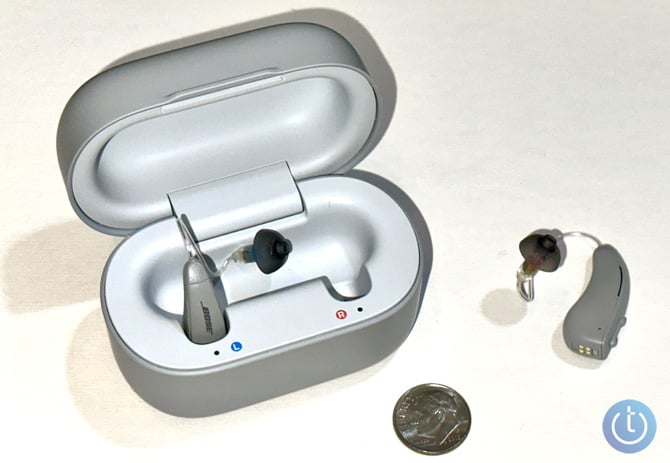
Which OTC hearing aid characteristics are most important to you is a personal usage decision. While the Lexie B2 OTC hearing aids provide outstanding sound enhancement, it'll be up to you if the aesthetic and function compromises you're forced to make – and the price you'll have to pay – are worth their impressive aural improvements.
Ergonomics and setup
The Lexie B2 OTC hearing aids have a typical over-the-ear style. A teardrop module containing power and volume controls and rechargeable batteries sits three-quarters above and behind your ear, with an attached "receiver wire" tendril that runs down the front of your ear into your canal. Unlike in-ear buds, you must wrestle each B2 on and into each ear. And each bud has to be manually turned on via a button at the rear of the module. You also can adjust the volume up and down via these module buttons. The buds automatically turn off when conveniently magnetically snapped back into the charging case.
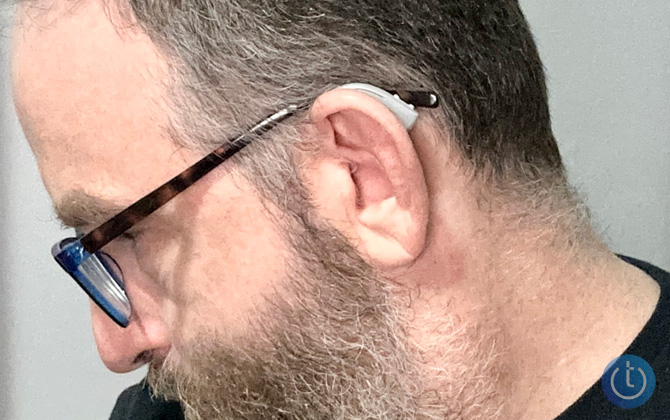
Even though the B2 module sits on your ear, the light grey coloring and placement make it virtually invisible – at least for those with lighter skin tones – unless someone looks at you from above and behind (Lexie's Lumen model comes in a wider variety of colors). The placement also shields the module from getting caught on shirts or pull-over sweaters when changing, and over-ear headphones worn over your ears feel fine.
There is no hearing test in the Lexie app to tune the Lexie B2s to conform to your specific hearing profile. Instead, the Lexie B2s are "self-tuning," which means you manually adjust the World Volume and tonal (bass/treble) levels to suit your hearing needs using the Lexie app. In addition to the World Volume and tonal (bass/treble) levels wheel controls, there is a separate left-right balance control in case your hearing loss in one ear is different from the other.
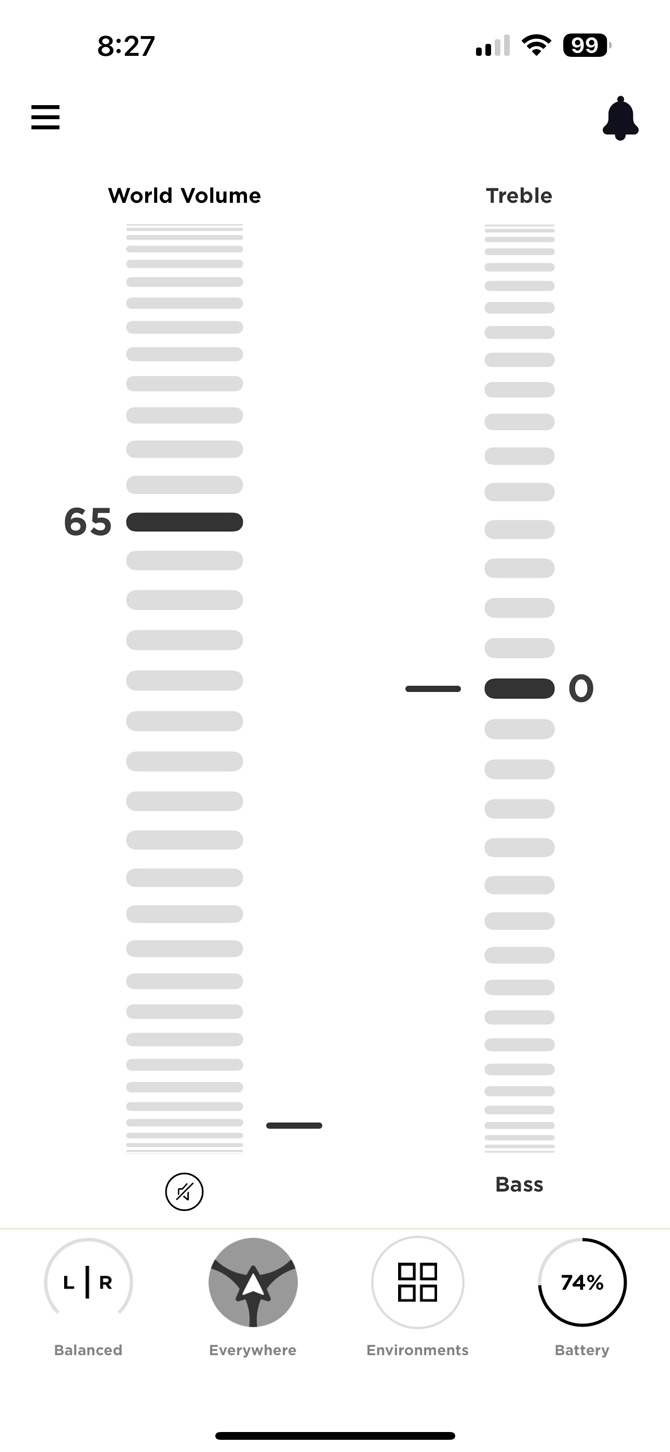
This DIY tuning technology "is an evolution from the hearing test-based approach you have experienced with other products," a Lexie exec told me. "Rather than relying on a wearer's feedback from a hearing test, this method relies on real-time tuning adjustments to learn their unique preferences and provide the clinically appropriate solution. And, of course, our Lexie customer solution team is ready and able to guide users who are not confident about adjusting the wheels themselves."
Lexie supplied Techlicious with clinical proof that its "self-fitting" DIY tuning approach is superior to the usual self-administered app hearing tests in the form of two journal articles: "Validation of a Self-Fitting Method for Over-the-Counter Hearing Aids" (Trends in Hearing, volume 24: 1–19) and "Comparing Population Coverage between Hearing Aids Using Presets vs Bose CustomTune" (The Hearing Review, June 3, 2021). However, three of the four authors of the first article are admitted Bose employees and their research was funded in part by Bose, and the lead author of the second piece is the same lead Bose researcher as the first article.
I remain cynical – I feel like I'm missing something without an app hearing test and subsequent automatic bud tuning for each ear. For a thousand bucks, I was hoping the Lexie B2s would be less DIY.
The B2s come with six pairs of silicone ear tips, which Lexie calls domes. The domes come in Size 1 = small, Size 2 = medium, and Size 3 = large (what happened to just S, M, and L?), and there are two types of domes – closed and open – in each size.
I initially stuck with pre-attached Size 2 open domes, which Lexie says fit 80 percent of users. However, the B2s squealed horribly whenever anything – my or my wife's hand, head, or arms, a neck cushion, pillow, etc. – came anywhere near my ears. This feedback is caused by the amplified sound from the speaker tips in your ears leaking out, bouncing off whatever is in physical proximity to your ear, then being picked up by the microphones on top of the teardrop modules on your ears.
One inadequate squeal-reducing solution is lowering the volume, which sort of defeats the whole World Volume self-adjustment theory discussed above. The more semi-effective solution is switching to larger, more ear-sealing closed domes. When the dome is set as deep in your canal as possible while still comfortable, it keeps amplified sound in your head with less leakage. When I switched to Size 3 closed domes, the squealing reduced slightly but not nearly enough to my satisfaction.
The best B2 fit and feedback results also depend on the receiver wire length (see the wire pointed out in the image below). As with the domes, the pre-attached wires go from the teardrop module to your ear. Lexie includes a measuring tool to ensure the included Size 2 wire is correct, and seven of the daunting 124-page manual pages are dedicated to measuring the receiver wire to determine if your fit is right. Unfortunately, Size 1 and Size 3 replacement receiver wires aren't included; they must be ordered separately by phone and are free during the 45-day trial period (the same as Eargo models) and $50 for one ear after that.
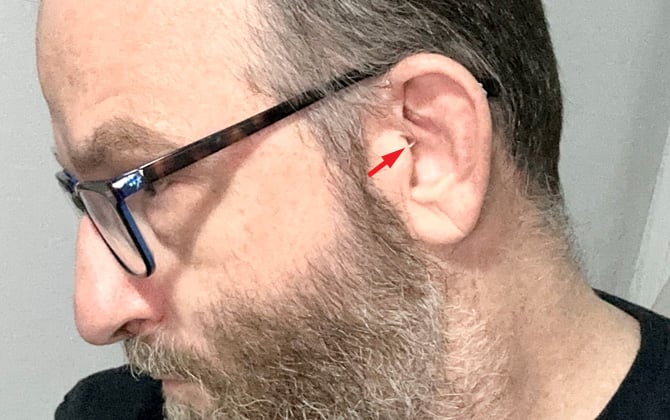
Performance
Once I got the volume/tone controls, dome size and type, and receiver wire measurement issues squared away, the Lexie B2 OTC hearing aids offer natural, satisfying sound amplification with no lag or echo between amplified and ambient sound.
Unlike the more aurally discriminating Sony CRE-C10s, the B2s amplify everything, including quieter sounds: light switches sound like rifle shots, creaking floorboards sound like breaking under my feet, keyboard taps sound like amplified tap dancing, and water from faucets sounds like Niagara Falls. And because the microphone is more exposed, the B2s pick up more wind noise than in-ear buds while lacking the wind noise suppression offered in the Sony CRE-C10s.
Since the modules include manual volume controls, it is easy to adjust volume levels by five percent, with each up or down tap to adjust to specific sonic circumstances.
Aside from volume and tone controls, the app also includes two directional presets: the default "Everywhere" for most use cases and "Front" for TV watching and when conversations are right in front of you. For example, in Everywhere mode, as I strolled down crowded Manhattan streets, I kept picking up nearby conversations that nearly blotted out the voice of my wife walking beside me. In Front mode, I needed to raise the volume by 5-10 percent to hear the conversation effectively.
You also get four environmental presets – Noisy Indoor, Outdoors, Music, and Everyday. You can customize each mode, but it takes a bit of work since you can't customize them until you find yourself in those aural situations, and who wants to be futzing with customizing an app when you're at a concert? The customization process itself is a bit complicated as well; it took a couple of trial-and-error attempts to figure it out.
To mute the buds, you must manually turn them off or take them off.
Because the microphone is on the above-ear module, you hear contact clinking each time you put on, move, or remove a pair of glasses. But if the B2s and your glasses fit firmly, you should experience minimal clinking over the day.
Battery and maintenance
The charging case does not contain its own battery; it charges the buds only when connected to AC power. Since the buds operate for up to 18 hours on a single charge, the larger charging case is designed not to be portable but stationary, to sit stolidly plugged into AC on a bedside table or desktop, and to be friendlier for those with finger dexterity issues. Complete recharging requires just three hours (the Eargo 5 buds require four hours of charging for 16 hours of usage).
In terms of maintenance and servicing, Lexie recommends replacing the receiving wires once a year for unclear reasons – and, at $100 a pair, there better be a good reason to replace them. Lexie also recommends replacing domes and wax guards every three months, but keeping these clean should elongate their effective life span. A tool to clear ear wax (yuck) off the domes and wax guards is included.
Four days after I received my review samples, I got a surprise check-in call from Lexie customer service. Apparently, when you purchase the B2s directly from Lexie, you get this call "immediately," presumably after registering the buds during the setup process. You then get a call once a month for the next three months and then a year later, all of which was nice and unexpected.
Summary
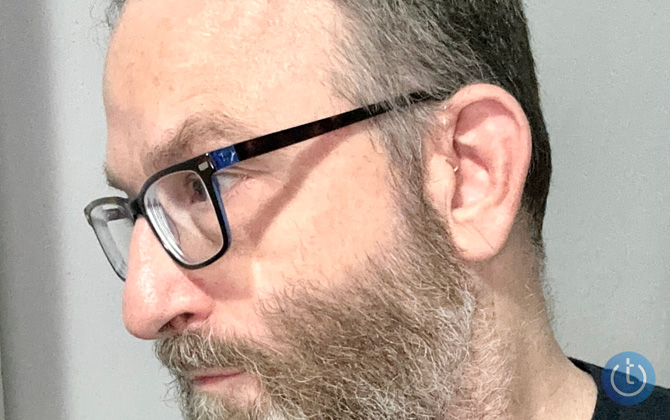
Once you get the tuning and dome/wire fit right, the Lexie B2 OTC hearing aids supply natural amplified sound. But so do the Sony CRE-C10, the B2's logical OTC hearing aid alternative, presenting a tough buying choice between the two. The B2 buds are more conveniently rechargeable, include on-bud volume controls, and offer excellent after-sale service. But they are clunkier than the Sony CRE-C10s, produce annoying feedback squeal, and amplify everything relatively equally, including wind. The Sony CRE-C10s are also more invisible with little feedback squealing, more aurally discriminating, and effective against wind noise, but require annoying and awkward replacement of single-use batteries every few days.
Which OTC hearing aids are better? I grudgingly prefer the Sony by a smidge, primarily because they don't squeal as much. But I also regret my choice each time I'd have to change those damned tiny batteries or run out and have to start hunting through drug stores for replacements.
As with all first-generation OTC hearing aids, at $999, the Lexie B2s are over-priced. I'm bemused by the section of the Lexie B2 web page explaining, "Why are Lexie OTC Hearing Aids so affordable?" – yes, affordable compared to insanely inflated prices charged by audiologists. Come back in a few months to see how a mass of OTC hearing aid competition redefines "affordable." Hopefully, as more vendors enter this new OTC hearing aid market, less expensive, rechargeable, non-squealing options will appear.
[Image credit: Stewart Wolpin/Techlicious]
Stewart Wolpin has been writing about consumer electronics for more than 35 years, including news, reviews, analysis and history, and has attended and covered nearly 50 Consumer Electronic Shows and around a dozen IFA shows in Berlin. For the Consumer Technology Association (CTA), he is an elector for and writes the official biographies of the annual CT Hall of Fame inductees, and is the keeper of the industry’s official history.
Discussion 
I just started using the Lexie B2 Powered by Bose. After four days of use (first timer) your article provides an excellent explanation for the squeal.
Since the article was written in January,I received mine around April 12 and the charger has to be connected to a USB power source(5v AC), not AC power.
My initial reactions are similar to what you’ve said. They do seem to meet my needs although the app needs some work on its interface. Could be a lot better. Music sounds natural and my wife says I already play music at a lower level which is helpful since her hearing is normal.
I have the B1’s which are the same as the B2’s with the annoying battery replacement every couple days. The “Battery Low” message is a bit too much for me. The squealing is intolerable. In some rooms by own breathing triggers the squealing. You would think they would put some anti-squealing logic in the firmware, but it doesn’t seem to have any. If I scratch my head, these amplifiers send out a noise that sends the dogs running and everyone in my proximity looking over in my direction. Quite annoying.



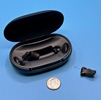

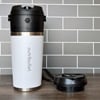

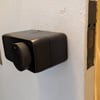


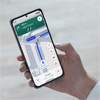

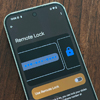

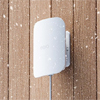
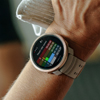

From Blaine on April 14, 2023 :: 10:06 am
finally a review site with real data that is useful.
Reply